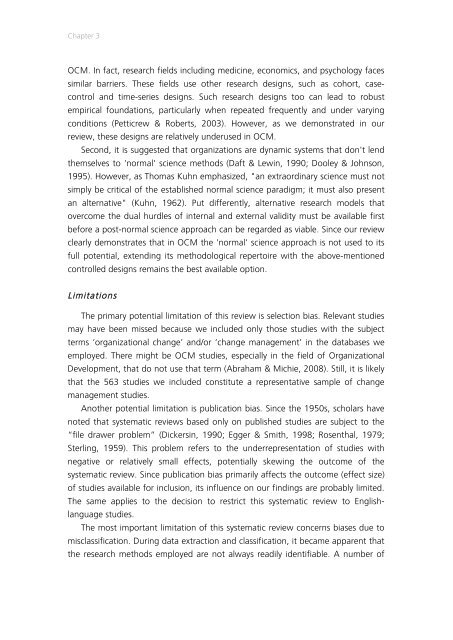In Search of Evidence
jqluvth
jqluvth
Create successful ePaper yourself
Turn your PDF publications into a flip-book with our unique Google optimized e-Paper software.
Chapter 3<br />
OCM. <strong>In</strong> fact, research fields including medicine, economics, and psychology faces<br />
similar barriers. These fields use other research designs, such as cohort, casecontrol<br />
and time-series designs. Such research designs too can lead to robust<br />
empirical foundations, particularly when repeated frequently and under varying<br />
conditions (Petticrew & Roberts, 2003). However, as we demonstrated in our<br />
review, these designs are relatively underused in OCM.<br />
Second, it is suggested that organizations are dynamic systems that don't lend<br />
themselves to 'normal' science methods (Daft & Lewin, 1990; Dooley & Johnson,<br />
1995). However, as Thomas Kuhn emphasized, "an extraordinary science must not<br />
simply be critical <strong>of</strong> the established normal science paradigm; it must also present<br />
an alternative" (Kuhn, 1962). Put differently, alternative research models that<br />
overcome the dual hurdles <strong>of</strong> internal and external validity must be available first<br />
before a post-normal science approach can be regarded as viable. Since our review<br />
clearly demonstrates that in OCM the 'normal' science approach is not used to its<br />
full potential, extending its methodological repertoire with the above-mentioned<br />
controlled designs remains the best available option.<br />
Limitations<br />
The primary potential limitation <strong>of</strong> this review is selection bias. Relevant studies<br />
may have been missed because we included only those studies with the subject<br />
terms ‘organizational change’ and/or ‘change management’ in the databases we<br />
employed. There might be OCM studies, especially in the field <strong>of</strong> Organizational<br />
Development, that do not use that term (Abraham & Michie, 2008). Still, it is likely<br />
that the 563 studies we included constitute a representative sample <strong>of</strong> change<br />
management studies.<br />
Another potential limitation is publication bias. Since the 1950s, scholars have<br />
noted that systematic reviews based only on published studies are subject to the<br />
“file drawer problem” (Dickersin, 1990; Egger & Smith, 1998; Rosenthal, 1979;<br />
Sterling, 1959). This problem refers to the underrepresentation <strong>of</strong> studies with<br />
negative or relatively small effects, potentially skewing the outcome <strong>of</strong> the<br />
systematic review. Since publication bias primarily affects the outcome (effect size)<br />
<strong>of</strong> studies available for inclusion, its influence on our findings are probably limited.<br />
The same applies to the decision to restrict this systematic review to Englishlanguage<br />
studies.<br />
The most important limitation <strong>of</strong> this systematic review concerns biases due to<br />
misclassification. During data extraction and classification, it became apparent that<br />
the research methods employed are not always readily identifiable. A number <strong>of</strong>


